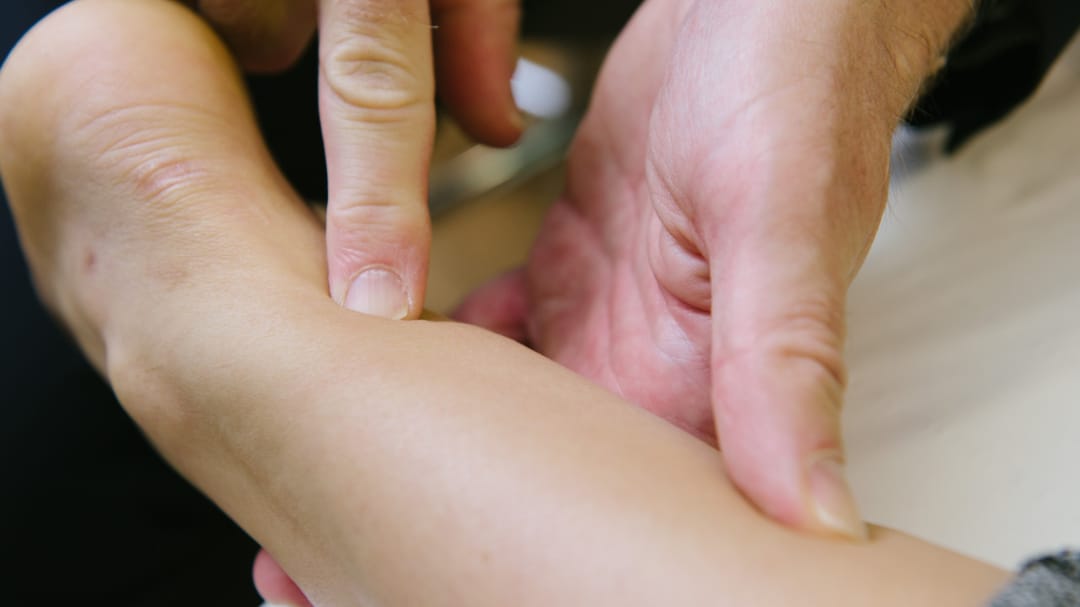What is: a Botulinum Toxin (BTX) Injection

Claire Small
Chief Clinical Officer & Consultant Physiotherapist
- 21 September, 2018
- Pain Management
- 6 min read
Botulinum toxin (BTX) is a protein that helps to reduce and stop muscle spasms when it is injected directly into the muscle. Muscle contractions are caused by neurotransmitters (chemical messengers) sent from nerves to the muscles.

These messengers tell the muscles when to contract (tighten up) and when to relax. When this finely tuned chemical messenger system malfunctions, the muscle can become overactive and irritable, resulting in painful muscle spasms. Over time, these problems can become chronic and have a significant negative effect on a patient’s quality of life. BTX acts by blocking signals from the nerves to the muscles.
Why Have a BTX injection?
The aim of BTX injections is to reduce muscle spasm and give you the pain and symptom relief you need. The injected muscle is no longer overactive which is one of several reasons why pain becomes less intense. The injections are not a cure but can enable the injured area to ‘reset’ and allow motor patterns to normalise over time. Contrary to public perception, the injected muscle is not ‘switched off’ completely.
These therapeutic injections are often part of your overall patient management plan which may include rehabilitation options such as physiotherapy, osteopathy, chiropractic, pilates and soft tissue therapy. There are occasions when an injection by itself may be highly effective. Often a series of BTX injections, carried out over a period of months, may be needed to successfully manage your pain symptoms and enable rehabilitation to occur.
Musculoskeletal Conditions Where BTX Injections May Benefit You
- Myofascial pain syndromes.
- Overactive myofascial trigger points (MTrPs).
- Recurrent muscle spasms and chronic pain.
- Cervical dystonias.
- Tension headaches.
- Focal upper and lower limb spasticity.
- Spasmodic torticollis.
- Hyperhidrosis of the axillae.
BTX injections are licensed for both medical and cosmetic purposes. At Pure Sports Medicine, these injections will only be offered for the medical conditions listed above. They will not be made available for cosmetic reasons. For avoidance of doubt, no BTX injections will be administered around the facial (face) area.
Which Techniques Will Be Used to Inject BTX Into The Muscle?
BTX is diluted with sterile saline (salt water) and injected into the muscles with a tiny needle. There are three main types of techniques that may be used
- Using Ultrasound imaging guidance.
- Using EMG guidance.
- Using anatomical landmarks.
Most patients will have a combination of the different types. The consultant delivering these injections will have extensive knowledge of how to deliver the injections using all 3 techniques.
A) Ultrasound-guided technique of injecting
Some of the BTX injections that are performed will be done so under ultrasound guidance. This means that we can observe the needle on the ultrasound screen and guide the needle to the intended target, thereby improving accuracy.
B) EMG-guided system technique of injecting
Needle EMG-guided injection can be also instrumental in improving the efficacy of treatment, reducing side effects and iatrogenic results. This technique is commonly used when administering BTX and provides valuable dynamic feedback.
C) Using anatomical landmarks for injection
Anatomy and landmark-guided BTX injections are very accurate and safe in the right hands. Examples of these include the shoulder girdle, piriformis, vastus medialis obliquus (VMO) and biceps muscle belly trigger points.
When Do BTX Injections Start to Work?
You will usually see the effects within 3 days. The maximum benefit is reached in 1-2 weeks.
How Long Does The Effect Last?
The symptom relief experienced from a single BTX injection will normally be sustained for between 3-6 months. This varies from patient to patient. You may notice a gradual reduction of its effects over time.
When Can The Injections Be Repeated?
BTX injections can be repeated in 3-6 months. In exceptional cases, the earliest it can be repeated is 2.5 months (approximately 10 weeks).
Are BTX Injections Safe?
BTX is made from the same bacterium that causes food poisoning. A high dose of BTX could be dangerous and fatal, just as food poisoning can be dangerous. However, the doses given in BTX injections are controlled and so small that it is unlikely you will suffer any harmful effects from the toxin. BTX has been used safely for over a decade.
How Long Can I Be Treated With BTX Injections?
Treatment can typically be repeated indefinitely. This form of therapy has now been in use for over a decade and its long term safely profile has been well established.
As BTX causes temporary muscle weakness as part of its intended therapeutic action, some patients may notice muscle atrophy in major muscle groups that are repeatedly injected.
Medical Conditions and Contraindications
As BTX injections are generally safe, there are not many medical problems that would prevent you from receiving one.
You may be advised to delay OR refrain from having a BTX injection at all if any of the following apply:
- Any obvious sign of infection over the area to be injected would mean an injection is not advisable till that resolves.
- If you are unwell with an acute illness (such as influenza or a chest infection), it is safer to postpone the procedure and wait until you are better.
- If you are taking any blood-thinning medication such as Warfarin or Aspirin, you must let your consultant know. Sometimes we can still inject but if appropriate, we may wish to reduce your Warfarin dose beforehand.
- If you are on muscle relaxants/ antidepressants/ sleeping medication.
- If you may be pregnant. If there is any doubt, a pregnancy test prior to having the injection is strongly advised. For safety reasons, being pregnant is an absolute contraindication to having these injections.
- If you are breastfeeding or intend to breastfeed.
- If you are known to be allergic or had severe side effects to Botulinum toxin injections in the past.
- You have a disease that affects your muscles and nerves (e.g. ALS or Lou Gehrig’s disease, myasthenia gravis) or breathing (e.g. severe asthma or COPD)
This list is not exhaustive. If you have any medical conditions or medications you feel may have a bearing on whether to have the injections, it is best to disclose them to your consultant in advance.
What Are Some of The Side Effects of BTX Injections?
Common side effects
You may experience soreness, mild swelling, bleeding and bruising in the area where the BTX has been injected. These often settle quickly within a few days. It can be helpful to take some pain relief (e.g. oral Paracetamol or Ibuprofen, as long as you are not known to be allergic to these medications) to alleviate these symptoms.
Rarer side effects
You may also experience the rarer side effects of severe weakness in the muscles injected, muscle soreness affecting your whole body, difficulty swallowing or speaking (more common in patients who have BTX injections near the throat), a red rash that lasts several days after the injections or an allergic reaction. Please alert your consultant if you experience any of these, particularly difficulty breathing, swallowing, speaking or any other allergic reactions. It is rare, but if these symptoms appear to be worsening, please seek emergency medical assistance immediately. Do not wait for a routine medical appointment.
Aftercare Following The Injection
We will ask you to wait in the clinic waiting room for 15 minutes after the injection where you can be observed, just to monitor for the slight chance of an allergic response.
- Do not exercise or massage the treated area as this can cause the BTX to migrate into undesired areas.
- We would advise you not to drive for several hours following the injection.
- It is best to avoid any strenuous activity for a couple of days.
- Physiotherapy and other rehabilitation can usually start after several days, as advised by your consultant.
- Your consultant will advise you to book a follow up appointment (usually after a few weeks) to check your response to the injection.
Selected references:
- Use of botulinum toxin in the treatment of chronic myofascial pain. De Andres J et al. Clin J Pain. 2003 Jul-Aug;19(4):269-75.
- The efficacy of botulinum toxin type A in managing chronic musculoskeletal pain: a systematic review and meta analysis. Zhang T et al. Inflammopharmacology. 2011 Feb;19(1):21-34. doi: 10.1007/s10787-010-0069-x. Epub 2010 Nov 13.
- Injection therapies for plantar fasciopathy (‘plantar fasciitis’): a systematic review and network meta-analysis of 22 randomised controlled trials. Tsikopoulos K et al. Br J Sports Med. 2016 Nov;50(22):1367-1375. doi: 10.1136/bjsports-2015-095437. Epub 2016 May 3.
- Injection of botulinum toxin for treatment of chronic lateral epicondylitis: systematic review and meta-analysis. Kalichman L et al. Semin Arthritis Rheum. 2011 Jun;40(6):532-8. doi: 10.1016/j.semarthrit.2010.07.002. Epub 2010 Sep 6
- Botulinum toxin type A in chronic plantar fasciitis: clinical effects one year after injection. Diaz-Llopis IV et al. Clin Rehabil. 2013 Aug;27(8):681-5. doi: 10.1177/0269215512469217. Epub 2013 Feb 14.
- Botulinum Toxin Injections: A Treatment for Muscle Spasms. American Academy of Family Physicians website. (Accessed 22 Nov 2016) http://familydoctor.org/family..procedures-devices/botulinum-toxin-injections-a-treatment-for-muscle-spasms.html
- Botulinum toxin injections for low-back pain and sciatica. Waseem et al. Cochrane Database Syst Rev. 2011 Jan 19;(1):CD008257. doi: 10.1002/14651858.CD008257.pub2.
- Analgesic Effect of Botulinum Toxin A in Myofascial Pain Syndrome Patients Previously Treated with Local Infiltration of Aesthetic and Steroids. Cartagena-Sevilla J et al. J Pain Palliat Care Pharmacother. 2016 Nov 1:1-7. [Epub ahead of print]

Advice
Over the last 20+ years our experts have helped more than 100,000 patients, but we don’t stop there. We also like to share our knowledge and insight to help people lead healthier lives, and here you will find our extensive library of advice on a variety of topics to help you do the same.
OUR ADVICE HUBS See all Advice Hubs

